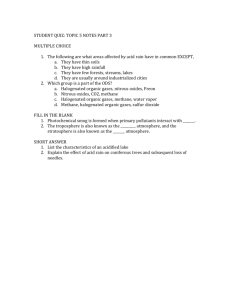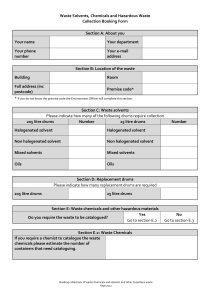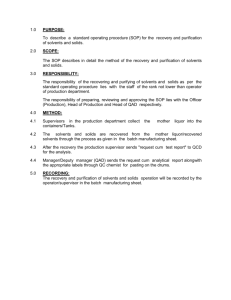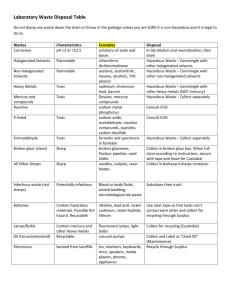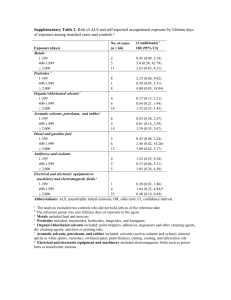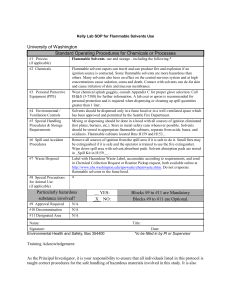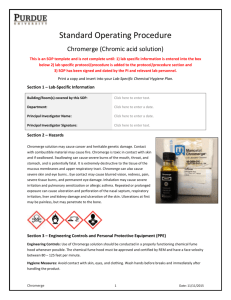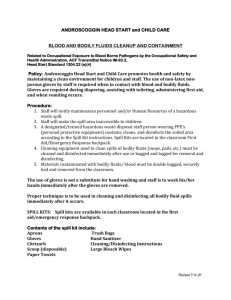Halogenated Solvents - Environmental Health & Safety
advertisement
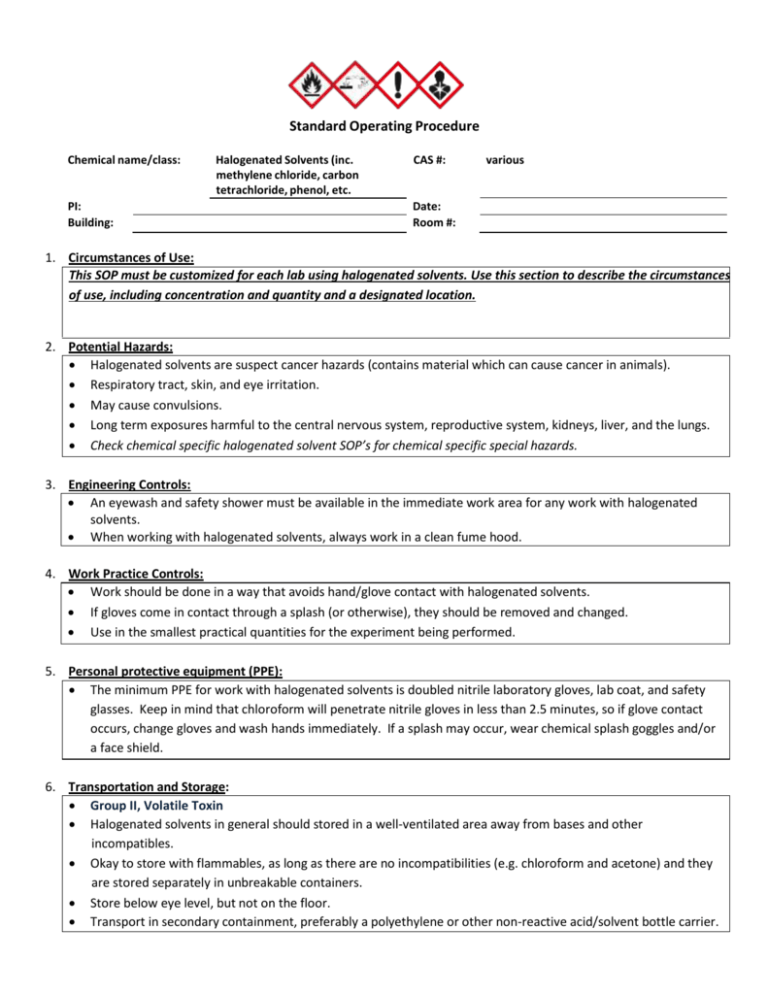
Standard Operating Procedure Chemical name/class: PI: Building: Halogenated Solvents (inc. methylene chloride, carbon tetrachloride, phenol, etc. CAS #: various Date: Room #: 1. Circumstances of Use: This SOP must be customized for each lab using halogenated solvents. Use this section to describe the circumstances of use, including concentration and quantity and a designated location. 2. Potential Hazards: Halogenated solvents are suspect cancer hazards (contains material which can cause cancer in animals). Respiratory tract, skin, and eye irritation. May cause convulsions. Long term exposures harmful to the central nervous system, reproductive system, kidneys, liver, and the lungs. Check chemical specific halogenated solvent SOP’s for chemical specific special hazards. 3. Engineering Controls: An eyewash and safety shower must be available in the immediate work area for any work with halogenated solvents. When working with halogenated solvents, always work in a clean fume hood. 4. Work Practice Controls: Work should be done in a way that avoids hand/glove contact with halogenated solvents. If gloves come in contact through a splash (or otherwise), they should be removed and changed. Use in the smallest practical quantities for the experiment being performed. 5. Personal protective equipment (PPE): The minimum PPE for work with halogenated solvents is doubled nitrile laboratory gloves, lab coat, and safety glasses. Keep in mind that chloroform will penetrate nitrile gloves in less than 2.5 minutes, so if glove contact occurs, change gloves and wash hands immediately. If a splash may occur, wear chemical splash goggles and/or a face shield. 6. Transportation and Storage: Group II, Volatile Toxin Halogenated solvents in general should stored in a well-ventilated area away from bases and other incompatibles. Okay to store with flammables, as long as there are no incompatibilities (e.g. chloroform and acetone) and they are stored separately in unbreakable containers. Store below eye level, but not on the floor. Transport in secondary containment, preferably a polyethylene or other non-reactive acid/solvent bottle carrier. 7. Waste Disposal: Separate halogenated from non-halogenated wastes. Handle and store wastes following the guidelines above while accumulating wastes and awaiting chemical waste pickup. Waste must be disposed of following your laboratory specific procedures and the requirements of UNC Charlotte’s Hazardous Waste Management Practices http://safety.uncc.edu/laboratory-safety/hazardousmaterialswaste . 8. Exposures/Unintended contact: If skin contact occurs, immediately remove contaminated clothing and rinse with soap and water for 15 minutes. If irritation persists, seek medical attention. For eye exposures, immediately rinse eyes with copious amounts of water for at least 15 minutes, while occasionally lifting upper and lower lids, then promptly seek medical attention. If inhaled, can have narcotic-like effects along with dizziness and disorientation. Move person to fresh air immediately and if necessary, seek medical attention. If is ingested, DO NOT induce vomiting and drink copious amounts of water. Contact the Student Health Center at 704-687-7400 for medical advice on occupational chemical exposures. For an actual chemical exposure, complete the work-related injury or illness report found at: http://safety.uncc.edu/workers-compensation/workers-compensation-section 9. Spill Procedure: In the case of a small spill (<500 ml) wear nitrile gloves and splash goggles and absorb spill of material with a spill pad, absorbant material (ground up corn cobs/slickwick) or lab wipes. (Bag spill materials in plastic bag for waste pickup.) Ventilate area and wash spill site with detergent and water On the UNC Charlotte campus, “large” spills of hazardous materials must be referred to the Campus Police by calling 911 from a campus phone or 704-687-2200 from any phone. 10. Training of personnel: All personnel are required to complete the UNC Charlotte EHS Laboratory Environment Training Checklist. This checklist includes an introduction to general chemical safety as well as review of the laboratory specific safety plan. Furthermore, all personnel shall read and fully adhere to this SOP when handling the chemical. “I have read and understand this SOP. I agree to fully adhere to its requirements.” Last First Duke ID Signature
